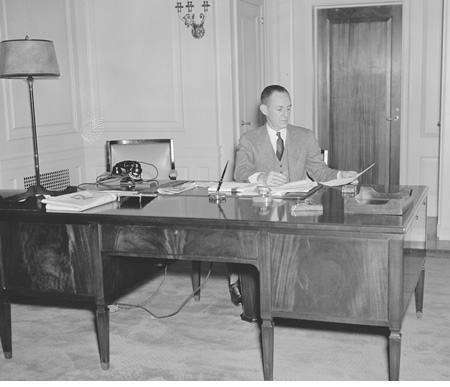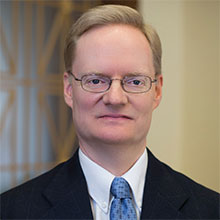The Banking Act of 1935
The Banking Act of 1935 created the modern form of the Federal Open Market Committee (FOMC), which is the Fed's principal monetary policymaking committee. The voting members of the FOMC are the seven members of the Fed's Board of Governors and five Reserve bank presidents. The chair of the Board also chairs the FOMC, and the president of the Federal Reserve Bank of New York serves as the FOMC's vice chair. Of the other 11 Reserve bank presidents, four serve at a time as voting members of the FOMC on a rotating basis, with each president voting every second or third year. All 12 presidents (or their representatives) attend and participate in the deliberations of every FOMC meeting; each president has the opportunity to present his or her views to the committee regardless of whether he or she currently is a voting member of the committee.
At various times, Congress has considered eliminating the role of Federal Reserve bank presidents in setting monetary policy or limiting the presidents to an advisory role. However, such proposals have never won much support, perhaps because there are clear benefits from the service of Reserve bank presidents as voting FOMC members, rather than as just advisers.

The St. Louis Fed's board of directors gathered in its boardroom in 1964 to mark the 50th anniversary of the Fed.
One benefit is that the participation of Reserve bank presidents in monetary policymaking contributes to the Fed's political independence. That is because the appointment process of Reserve bank presidents is more insulated from politics than is the appointment of Federal Reserve governors. Whereas members of the Board are appointed by the president of the United States and confirmed by the Senate, Reserve bank presidents are appointed by their respective Reserve bank boards of directors with the approval of the Board of Governors in Washington, D.C. 7 Many studies have found that political independence enhances central bank performance and that countries with independent central banks tend to have better-performing economies than do countries with less-independent central banks. 8
Some observers contend that a second benefit of having Reserve bank presidents in a policymaking role is that the opportunity to vote enables the Fed to attract more-talented individuals to serve as Reserve bank presidents than if presidents served merely as advisers to the Board. When asked in congressional hearings for his opinion about a proposed change in the Federal Reserve Act that would make all Reserve bank presidents nonvoting members of the FOMC, Cleveland Fed President and former St. Louis Fed Research Director Jerry Jordan testified: "Making the presidents [of Federal Reserve banks] nonvoting members ... would alter the Federal Reserve substantially and in a very harmful way. It would not be a job I would want—it would destroy the system." 9

Marriner Eccles, who served as Fed chairman from 1934 through 1948, argued that the Federal Reserve Board should have the sole responsibility for monetary policy. He advocated legislation to reduce or eliminate the role of the Reserve banks in monetary policymaking.
More broadly, the participation of Reserve bank presidents on the FOMC contributes to monetary policymaking in the United States by ensuring a greater diversity of views in policy deliberations. Over time, the Fed's structure ensured that the differences in banking and economic conditions across the nation were recognized in policy deliberations. Almost from the System's beginning, the Reserve banks invested in gathering and reporting information about banking and economic conditions in their districts for use in monetary policymaking, as well as in banking supervision and other operations of the bank. To this day, Federal Reserve bank directors, advisory council members and other local contacts continue to provide important information about district conditions for use in policymaking. (See the essay "Structure and Governance" for more on the role of Reserve bank directors.)
In addition to bringing information about economic conditions in their districts to the policy table, Reserve bank presidents are supported by economic research teams with independent policy analysis and research. Reserve bank economists report only to their respective bank presidents and not to members of the Board of Governors or its staff. This arrangement helps ensure a hearing for diverse views and limits "groupthink" in policy analysis and at FOMC meetings.
ENDNOTES
7. The Dodd-Frank Wall Street Reform and Consumer Protection Act of 2010 amended the Federal Reserve Act to remove Class A directors of Reserve banks from the process of appointing Reserve bank presidents and first vice presidents. At present, those officers are appointed by the Class B and C directors with the approval of the Board of Governors (Section 4 of the Federal Reserve Act [12 USC 341]).
8. See Waller for more on the rationale for central bank independence and how the Fed's structure contributes to its political independence.
9. H.R. 28, the Federal Reserve Accountability Act of 1993, Hearing before the Committee on Banking, Finance, and Urban Affairs, House of Representatives, Oct. 19, 1993, p. 35.



